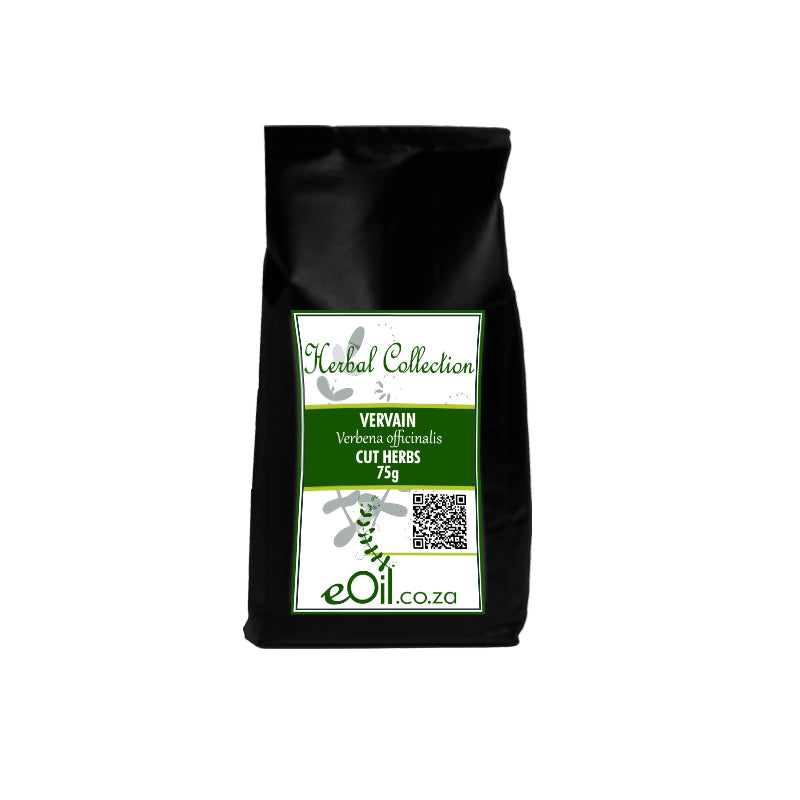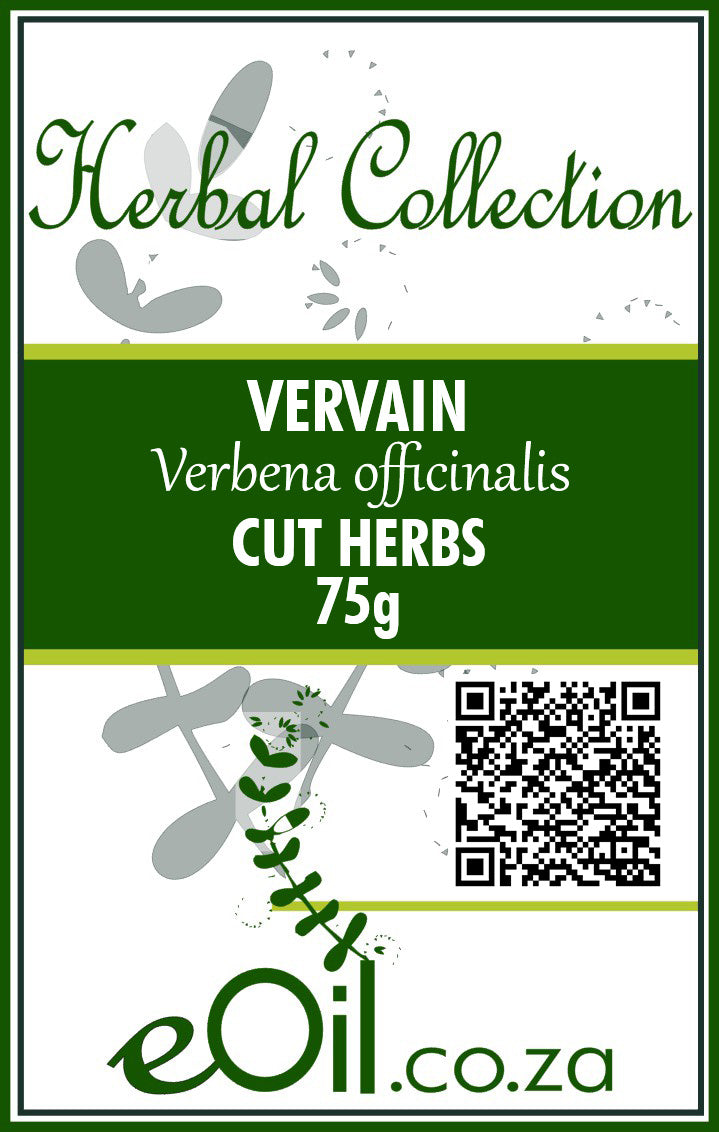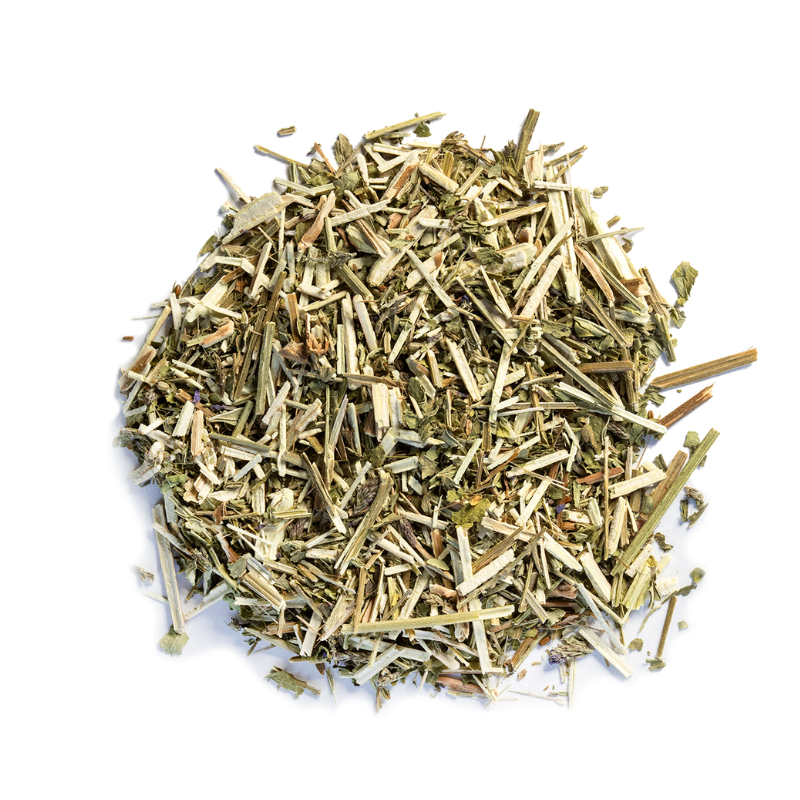Vervain Herb Dried ( Verbena officinalis ) - Herbal Collection
Vervain Herb Dried ( Verbena officinalis ) - Herbal Collection - 75 GR is backordered and will ship as soon as it is back in stock.
Description
Description
Vervain Herb Dried (Verbena officinalis) consists of the leaves and flowers of a traditional European and African herb, valued for its soothing aroma and gentle plant compounds.
Commonly prepared as a caffeine-free herbal tea, vervain is used to support relaxation, ease nervous tension, and soothe the throat.
Naturally rich in antioxidants and flavonoids, it’s suitable for daily wellness routines.
TRADITIONALLY USED FOR
What is Vervain?
Vervain (Verbena officinalis) is a perennial flowering herb that belongs to the Verbenaceae family. It has a long history of use in traditional medicine practices.
Traditional Uses of Vervain Herb Dried Tisane
Calming and Stress Relief: Vervain is believed to have a soothing effect on the nervous system, making it a popular choice for anxiety, stress reduction, and promoting relaxation.
Vervain tea for calming and stress relief
- Sleep Aid: Its calming properties also make it useful as a natural sleep aid.
- Digestive Support: Vervain may help ease digestion-related issues such as bloating and gas.
- Women's Health: Some traditional uses include support during menstruation and to potentially increase milk production during breastfeeding.
- Other Potential Benefits: Vervain has also been traditionally used to support immune function and reduce fevers.
How to Prepare Vervain Herb Dried Tisane
- Dosage: Use approximately 1-2 teaspoons of dried vervain herb per cup of hot water.
- Steeping: Steep the dried herb in hot water (not boiling) for 5-10 minutes.
- Straining: Strain the tea to remove any herb particles.
- Sweetener (Optional): If desired, you can add honey or your preferred sweetener to taste.
Important Considerations
- Consult Your Doctor: It's always best to talk to your doctor before using vervain, especially if you are pregnant, breastfeeding, or have any existing medical conditions.
- Potential Interactions: Vervain may interact with certain medications, so it's important to be aware of possible interactions.
INFORMATION
Source : http://www.wikiphyto.org/wiki/Verveine_odorante
Reference on http://www.wikiphyto.org
Translation in English by Google Translate (go to the page of the source linked | on Chrome cellphones go on the 3 dots on the top right and select translate in your preferred language | on laptop right click your mouse and select option translate when hoovering on the page
plant name
Verbena officinalis, Sacred herb , Herb of Venus , Heal-all
- English: common vervain
- Anglais : vervain
- Spanish: verbena, curasana
- Italien: sacred herb, common verbena
International Latin denomination
botanical family
Verbenaceae
Description and habitat
- Herbaceous plant of wastelands, 30 to 80 cm
- Very slender branched quadrangular stem, with two longitudinal furrows
- Leaves rough, pinnatisect, with unequal lobes
- Long slender terminal spikes of flowers with 5 rounded lilac lobes
- Cosmopolitan, Europe, Asia, Africa, America
History and tradition
- It seems that it was considered sacred in Europe. Its name is of Celtic origin. Traditional medicine used it in many conditions: asthma, whooping cough, cramps, fatigue, nervous disorders, kidney and digestive disorders, as an emmenagogue [1] . She is known to Hippocrates, Hildegard of Bingen, Paracelsus, etc.
- Alongside its therapeutic properties, it was also attributed magical properties (magicians' enchantments, crowns for the heralds of arms among the Greeks, cleaning of altars before sacrifices, gathering by druids with special ceremonies, etc.)
- It was mainly used in the 19th century as a febrifuge, analgesic, diuretic, diaphoretic and expectorant. Leclerc reports it in trigeminal neuralgia
- The Council of Europe considers verbena as a class 2 source of food flavouring. For the Food and Drugs Administration, verbena is a "herb of undefined safety".
Parts used
- flowering plant
Dosage forms available
- Whole plant tincture
- Fluid extract
- Flowering aerial part for herbal tea
Usual dosages
- Dry drug 2-4 g in infusion, 3 times a day
- Fluid extract (1:1, 25% alcohol) 2-4 ml, three times a day
- Tincture (1:1 in 40% alcohol) 5-10 ml three times a day
Composition
Main components of the plant
- Flavonoids :
- Apigenin and derivatives, 4'-hydroxywogonine
- Artémétine (flavone)
- Lutéoline 7-diglucuronide [2]
- Iridoides : verbenalide , invertine , mulch , verbene , hastatoside [3] , verbenose A , verbenose B [4] , verbeofflin [5]
- Verbenone essential oil
- Polyphenols (65%) : caffeic acid derivatives ( verbascoside ) (400 mg/l), aucubin , luteolin-7-diglucuronide (100 mg/l)
- Mucilages, tanins
- Others: Triterpenes and steroids , ursolic acid , oleanolic acid and their derivatives, lupeol , beta-sitosterol , stachyosis (23.2%)
Main components of buds or young shoots
Main components of essential oil
Properties
Plant properties
- Pharmacological properties:
- Secretolytic and expectorant effect. These long-known effects have been demonstrated again by Chabanguza and Gui respectively on the extract and are related to verbenaline
- Anti-inflammatory [6] , [7] , anti-gastritic effect of VoEF and VoCO2 extracts per os and local anti-inflammatory and analgesic effects have been demonstrated. They are related to flavonoids and iridoids (more specifically)
- Antioxidant effect [8]
- Immunological and anti-infective effect
- The aqueous extract inhibits neutrophil phagocytosis with an increase in interleukin-6 synthesis in macrophages. The ethanol extract inhibits the growth of Salmonella , Shigella and Bacillus subtilis . (Debrauwer). Verbena extract is said to have an antiviral effect on herpes virus and monkey cytomegalic virus
- Endocrine effects
- Healing effect (supercritical CO2 extract), anti-inflammatory and local analgesic [12]
- Antifungal and antiradical effect of methanolic leaf extract [13]
- Nervous system effects
- Anticonvulsant [14] , sedative, anxiolytic [15] , [16]
- Antidepressant [17] , [18]
- Sleep inducer ( verbenaline , hastatoside ) [19]
- Verbenaloside would be a weak parasympathomimetic (with lowering of BP, regulates transit). Verbenin , in vitro, in low doses stimulates and in high doses inhibits the sympathetic nerve innervating the heart, vessels, intestines and salivary gland
- Neuroprotecteur [20]
- Cytoprotective effect of the cells of the central nervous system by the oral route of the aqueous extract of Verbena sativa . It opposes beta-amyloid peptide and dithiothreitol toxicity in cortical nerve cells
- Gastric cytoprotection (Speroni)
Bud properties
Properties of essential oil
Indications
Indications of the whole plant (phytotherapy)
- Digestive disorders, gastritis and ulcers, hiatal hernia
- Nervous breakdowns
- Prefer it during postpartum depression because of its activity of releasing LH and FSH hormones by the pituitary gland and its estrogenic and progestin activity
- Nocturnal hot flashes [22]
- Anxiety
- Migraines cataméniales
- Acne [23]
- Autoimmune diseases?
- None of these indications have been really validated
- According to Commission E, the use of verbena officinalis is not recommended, due to the lack of evidence of its effectiveness. No monograph is available in France
- The aerial parts of verbena will remain in traditional use:
- In congestion coughs with risk of infection, and in febrile states
- Comme substance digestive
Indications of the bud (gemmotherapy)
Specific indications of essential oil (aromatherapy)
Known or suspected mode of action
- Verbenaloside provides by hydrolysis of verbenalol
- Verbena infusions cause the release of LH and FSH by the pituitary
Usual formulations
Regulations
- French Pharmacopoeia list A (aerial part)
Possible side effects and precautions for use
- The toxicity is not sufficiently known. The drug could stimulate the uterus and be abortifacient
- Verbena should not be recommended during pregnancy
- Teratogenic and embryotoxic in rats [24]
- Side effects :
- Verbena tea can reduce iron absorption [25]
- It should be avoided in case of lack of iron
- Interactions with other medications are not known
- NOTE: Common verbena ( Verbena officinalis ) should not be confused with lemon verbena ( Lippia citriodora ) .
Bibliographic references
- Go↑ Elahi, A., Fereidooni, A., Shahabinezhad, F., Ajdari Tafti, M., & Zarshenas, M. M. (2016). An overview of amenorrhea and respective remedies in Traditional Persian Medicine. Trends in Pharmaceutical Sciences, 2(1), 3-10.
- Go↑ Carnat A, Carnat AP, Chavignon O, Heitz A, Wylde R, Lamaison JL. Luteolin 7-diglucuronide, the major flavonoid compound from Aloysia triphylla and Verbena officinalis. Planta Med. 1995 Oct;61(5):490. PMID 7480218
- Go↑ Tian J, Zhao YM, Luan XH. [Studies on the chemical constituents in herb of Verbena officinalis]. Zhongguo Zhong Yao Za Zhi. 2005 Feb;30(4):268-9. PMID 15724402
- Go↑ Xu W, Xin F, Sha Y, Fang J, Li YS. Two new secoiridoid glycosides from Verbena officinalis. J Asian Nat Prod Res. 2010 Aug;12(8):649-53. doi: 10.1080/10286020.2010.489820. PMID 20706899
- Go↑ Shu J, Chou G, Wang Z. Two new iridoids from Verbena officinalis L. Molecules. 2014 Jul 18;19(7):10473-9. doi: 10.3390/molecules190710473. PMID 25045888
- Go↑ Deepak M, Handa SS. Antiinflammatory activity and chemical composition of extracts of Verbena officinalis. Phytother Res. 2000 Sep;14(6):463-5. PMID 10960904
- Go↑ Calvo MI, Vilalta N, San Julián A, Fernández M. Anti-inflammatory activity of leaf extract of Verbena officinalis L. Phytomedicine. 1998 Dec;5(6):465-7. doi: 10.1016/S0944-7113(98)80043-3. PMID 23196030
- Go↑ Sheyla Rehecho, Olman Hidalgo, Mikel García-Iñiguez de Cirano, Iñigo Navarro, Iciar Astiasarán, Diana Ansorena, Rita Yolanda Cavero, María Isabel Calvo. Chemical composition, mineral content and antioxidant activity of Verbena officinalis L. LWT - Food Science and Technology, Volume 44, Issue 4, May 2011, Pages 875–882 [1]
- Go↑ Zava DT , Dollbaum CM , Blen M . Estrogen and progestin bioactivity of foods, herbs, and spices . Proc Soc Exp Biol Med . 1998 ; 217 ( 3 ): 369-378. PMID 9492350
- Go↑ Kuwajima, K. (1939). Chemical and pharmacological studies on verbenine, a galactogogic glycoside from Verbena officinalis L. The Tohoku Journal of Experimental Medicine, 36(1), 28-43.
- Go↑ E Winde, I Echaust, R Haensel. [Verbena officinalis: occurrence of adenosine and beta-carotene. On the problem of "verbenin" described by Kuwajima] Arch Pharm Ber Dtsch Pharm Ges. 1961 Apr;294/66:220-9. doi: 10.1002/ardp.19612940405. PMID 13785767
- Go↑ Calvo MI. Anti-inflammatory and analgesic activity of the topical preparation of Verbena officinalis L. J Ethnopharmacol. 2006 Oct 11;107(3):380-2. PMID 16723201
- Go↑ Casanova E, García-Mina JM, Calvo MI. Antioxidant and antifungal activity of Verbena officinalis L. leaves. Plant Foods Hum Nutr. 2008 Sep;63(3):93-7. doi: 10.1007/s11130-008-0073-0. PMID 18498054
- Go↑ Rashidian A, Kazemi F, Mehrzadi S, Dehpour AR, Mehr SE, Rezayat SM. Anticonvulsant Effects of Aerial Parts of Verbena officinalis Extract in Mice: Involvement of Benzodiazepine and Opioid Receptors. J Evid Based Complementary Altern Med. 2017 Oct;22(4):632-636. doi: 10.1177/2156587217709930. PMID 28585447
- Go↑ Khan Abdul Waheed, Khan Arif-Ullah, Ahmed Touqeer. Anticonvulsant, Anxiolytic, and Sedative Activities of Verbena officinalis. Frontiers in Pharmacology, 2016, vol. 7. texte intégral
- Go↑ Kathy Abascal, Eric Yarnell. Nervine Herbs for Treating Anxiety. Alternative and Complementary Therapies. December 2004, 10(6): 309-315. doi:10.1089/act.2004.10.309.
- Go↑ Jawaid, T. A. L. H. A., Imam, S. A., & Kamal, M. E. H. N. A. Z. (2015). Antidepressant activity of methanolic extract of Verbena officinalis Linn. plant in mice. Asian J Pharm Clin Res, 8(4), 308-310.
- Go↑ Jawaid, T., Gupta, R., & Siddiqui, Z. A. (2011). A review on herbal plants showing antidepressant activity. International Journal of Pharmaceutical Sciences and Research, 2(12), 3051.
- Go↑ MAKINO, Yuki & KONDO, Shino & NISHIMURA, Yoshiko & TSUKAMOTO, Yoshinori & Huang, Zhi-Li & Urade, Yoshihiro. (2009). Hastatoside and verbenalin are sleep‐promoting components in Verbena officinalis. Sleep and Biological Rhythms. 7. 211 - 217. 10.1111/j.1479-8425.2009.00405.x.
- Go↑ Lai SW, Yu MS, Yuen WH, Chang RC. Novel neuroprotective effects of the aqueous extracts from Verbena officinalis Linn. Neuropharmacology. 2006 May;50(6):641-50. PMID 16406021
- Go↑ De Martino L, D'Arena G, Minervini MM, Deaglio S, Fusco BM, Cascavilla N, De Feo V. Verbena officinalis essential oil and its component citral as apoptotic-inducing agent in chronic lymphocytic leukemia. Int J Immunopathol Pharmacol. 2009 Oct-Dec;22(4):1097-104. PMID 20074474
- Go↑ Abascal, K., & Yarnell, E. (2013). Night Sweats in Perimenopause and Beyond. Alternative and Complementary Therapies, 19(1), 28-32.
- Go↑ Eric Yarnell and Kathy Abascal. Herbal Medicine for Acne Vulgaris. Alternative and Complementary Therapies. December 2006, 12(6): 303-309. texte intégral
- Go↑ Abdulmannan H. Fateh, Zahurin Mohamed, Zamri Chik, Abdulsamad Alsalahi, Siti Rosmani Md Zin, Mohammed A. Alshawsh. Prenatal developmental toxicity evaluation of Verbena officinalis during gestation period in female Sprague-Dawley rats. Chemico-Biological Interactions, Volume 304, 2019, Pages 28-42, https://doi.org/10.1016/j.cbi.2019.02.016. (http://www.sciencedirect.com/science/article/pii/S0009279718314765)
- Go↑ Zaida F, Bureau F, Guyot S, Sedki A, Lekouch N, Arhan P, Bouglé D. Iron availability and consumption of tea, vervain and mint during weaning in Morocco. Ann Nutr Metab. 2006;50(3):237-41. PMID 16508250
- Teuscher Eberhard, Anton Robert, Lobstein Annelise. Aromatic plants: Spices, herbs, condiments and essential oils. Ed. Tec & Doc. Cachan. 2005. p. 590
- Pignol S. Thesis in Pharmacy (90-974) Strasbourg, April 1990
- Fintelmann V., Menßen HG, Siegers CP Phytotherapy Manual Hippocrates Verlag Stuttgart 1989
- Speroni E, Cervellati R, Costa S, Guerra MC, Utan A, Govoni P, Berger A, Müller A, Stuppner H. Effects of differential extraction of Verbena officinalis on rat models of inflammation, cicatrization and gastric damage. Planta Med. 2007 Mar;73(3):227-35. PMID 17354166
- Petri G., Nyiredi K., Nyiredi Sz. Modern therapeutic application of herbs. Ed. Medicine Budapest 1989
- Auf'mkolk M , Ingbar JC , Amir SM , et al. Inhibition by certain plant extracts of the binding and adenylate cyclase stimulatory effect of bovine thyrotropin in human thyroid membranes . Endocrinology. 1984 ; 115 ( 2 ): 52. PMID 6745167
CAUTION
Store in a cool, dry place, away from light. Keep tightly closed, away from the reach of Children and pets.
Do not exceed the daily dose.
This product is not intended to prevent or cure any form of illness or disease.
If you are pregnant or nursing ; If you have a medical condition or are in the course of medical treatment ; If you are programmed for theater/operation in the near future, please consult your healthcare practitioner before using this product.
This product cannot replace a varied and balanced diet and a healthy lifestyle.
This product has not been evaluated by the SAHPRA for its quality, safety or intended use.
For More Information please check our General Safety Herbal products Page






